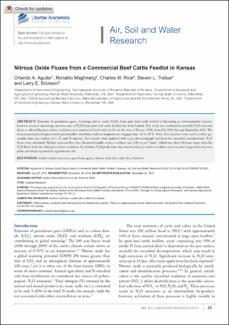Mostrar el registro sencillo del ítem
Nitrous Oxide Fluxes from a Commercial Beef Cattle Feedlot in Kansas
| dc.contributor.author | A. Aguilar, Orlando | |
| dc.contributor.author | Maghirang, Ronaldo | |
| dc.contributor.author | W. Rice, Charles | |
| dc.date.accessioned | 2018-03-16T20:24:35Z | |
| dc.date.accessioned | 2018-03-16T20:24:35Z | |
| dc.date.available | 2018-03-16T20:24:35Z | |
| dc.date.available | 2018-03-16T20:24:35Z | |
| dc.date.issued | 2014-03-10 | |
| dc.date.issued | 2014-03-10 | |
| dc.identifier | http://journals.sagepub.com/doi/abs/10.4137/ASWR.S12841 | |
| dc.identifier.issn | 11786221 | |
| dc.identifier.uri | http://ridda2.utp.ac.pa/handle/123456789/4424 | |
| dc.identifier.uri | http://ridda2.utp.ac.pa/handle/123456789/4424 | |
| dc.description | Emission of greenhouse gases, including nitrous oxide (N2O), from open beef cattle feedlots is becoming an environmental concern; however, research measuring emission rates of N2O from open beef cattle feedlots has been limited. This study was conducted to quantify N2O emission fluxes as affected by pen surface conditions, in a commercial beef cattle feedlot in the state of Kansas, USA, from July 2010 through September 2011. The measurement period represented typical feedlot conditions, with air temperatures ranging from -24 to 39°C. Static flux chambers were used to collect gas samples from pen surfaces at 0, 15, and 30 minutes. Gas samples were analyzed with a gas chromatograph and from the measured concentrations, fluxes were calculated. Median emission flux from the moist/muddy surface condition was 2.03 mg m−2 hour−1, which was about 20 times larger than the N2O fluxes from the other pen surface conditions. In addition, N2O peaks from the moist/muddy pen surface condition were six times larger than emission peaks previously reported for agricultural soils. | en_US |
| dc.description.abstract | Emission of greenhouse gases, including nitrous oxide (N2O), from open beef cattle feedlots is becoming an environmental concern; however, research measuring emission rates of N2O from open beef cattle feedlots has been limited. This study was conducted to quantify N2O emission fluxes as affected by pen surface conditions, in a commercial beef cattle feedlot in the state of Kansas, USA, from July 2010 through September 2011. The measurement period represented typical feedlot conditions, with air temperatures ranging from -24 to 39°C. Static flux chambers were used to collect gas samples from pen surfaces at 0, 15, and 30 minutes. Gas samples were analyzed with a gas chromatograph and from the measured concentrations, fluxes were calculated. Median emission flux from the moist/muddy surface condition was 2.03 mg m−2 hour−1, which was about 20 times larger than the N2O fluxes from the other pen surface conditions. In addition, N2O peaks from the moist/muddy pen surface condition were six times larger than emission peaks previously reported for agricultural soils. | en_US |
| dc.language | eng | |
| dc.language.iso | eng | en_US |
| dc.rights | https://creativecommons.org/licenses/by-nc-sa/4.0/ | |
| dc.rights | info:eu-repo/semantics/openAccess | |
| dc.subject | feedlot surface emissions | en_US |
| dc.subject | greenhouse gases | en_US |
| dc.subject | nitrous oxide flux | en_US |
| dc.subject | static flux chambers | en_US |
| dc.subject | feedlot surface emissions | |
| dc.subject | greenhouse gases | |
| dc.subject | nitrous oxide flux | |
| dc.subject | static flux chambers | |
| dc.title | Nitrous Oxide Fluxes from a Commercial Beef Cattle Feedlot in Kansas | en_US |
| dc.type | info:eu-repo/semantics/article | |
| dc.type | info:eu-repo/semantics/publishedVersion |
